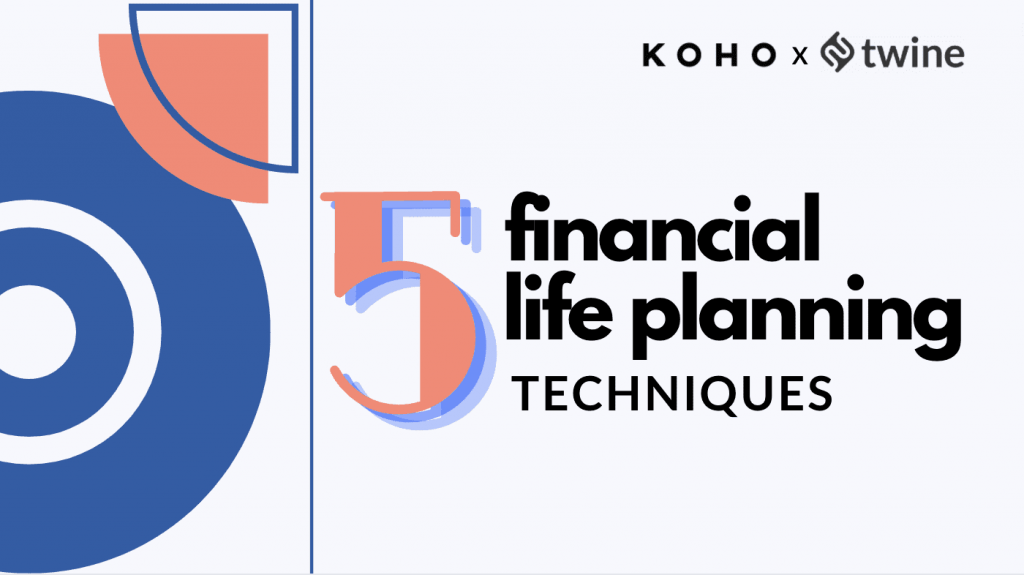
Financial life planning sounds easy, right?
Today over 40% of millennials in Canada have participated in freelance work – and for good reason. The allure of working for yourself and setting your own hours can be very idyllic and freeing: you set your own hours, choose who to work with, and make your own rules.
But then, the reality usually sets in. There’s a lot more work to it than originally meets the eye.
As a freelancer, you’re in charge of all the administrative duties and stresses that come with entrepreneurship, including managing all your finances. The good news? You can make it way easier on yourself, by developing some smart financial life planning habits now.
Fear not. We’ve spoken to a few freelance and finance experts who have decided to share their wisdom with you – the aspiring (or current!) freelancer.
1. Pay your salary first

The golden rule in personal finance is especially important when you work for yourself: Pay yourself first.
Income as a freelancer is wildly variable; some months you might feel like the richest person you know, while others may have you wondering how you’ll afford to pay your bills. To head off this “feast or famine” cycle, be sure to pay yourself a regular salary.
Take a look at your past few years of income, recommends financial counselor Jessica Moorhouse. Figure out your average monthly income over that period and commit to paying yourself that salary each month. This way, you’ll know how much money you’ll need to cover all the essentials, like bills, food, and rent. Jessica recommends taking a conservative approach when doing these calculations. After all, you want to make sure you don’t spend more than you make.
2. Know what to charge

Many experienced freelancers and contractors claim they were too afraid to charge what they wanted for their services early on in their careers.
Whether you’re working for a startup or running your own show entirely, take the time to research your field and the true price tag that your skills cost in the market. Knowing the current value of your skills and experience will help you gain confidence in charging an honest and fair fee.
It’s also important to take the time to determine what you value most in order to gain balance between your work and home life. If money isn’t your biggest priority, you may want to try negotiating more flexible work terms, equity in a company, or more creative liberties.
Salary should not be the only factor when determining your full worth and wants.
Equity—partial ownership in a company, often in exchange for a lower salary—can be an alluring but potentially risky option, especially with young startups. However, if you can negotiate it as part of your overall compensation package, it might pay dividends later on in your career.
3. Create a safety net

Your income while freelancing is much less predictable than it is when working a 9-5. You might have to weather slower months, become ill and not be able to work for a while, or need to take time off work for personal reasons.
You’ll want to have a slush fund or safety net to ensure you’re able to meet all your financial obligations, even during slower periods. Having an emergency fund will also come in handy if you require new equipment for work, like a computer.
Jessica recommends having three to six months of living expenses saved up (if you’re an employee) and nine to twelve months if you’re a freelancer.
For her part, Vass Bednar, who works as head of public policy at Delphia, a relatively new data-driven investment company based in Toronto, recommends setting autopayments to transfer a specific amount of money into an emergency fund. That’s in addition to making regular contributions to longer-term savings. A super-easy way to manage several savings targets is to use KOHO Goals.
Now, how much you should be putting in longer-term savings accounts will depend entirely on where you are in life, what your goals are, and what your income is. David Sax, the author of The Soul of an Entrepreneur, works with an accountant every year to figure out how much to invest for longer-term goals. He and his wife -also self-employed -have enough of a financial cushion to afford all of life’s necessities (for their family of four) for an entire year.
Once you have a few years of experience as a freelancer, you’ll be able to anticipate fluctuations in your income. You should also allow for some flexibility in your budget between seasons – especially since unpredictable costs will come up regularly when you’re self-employed. It’s important to live conservatively, even in your most lucrative months, to ensure you don’t have to dip into your slush fund savings.
4. Have an end game

No matter how good your financial life planning system is, you still need an end goal.
Gloria Dickie, a travel journalist, says it’s common among her peers to believe they’ll work forever. No matter how much you love your job, though, you should plan for when your career is over.
If you do what you love, it can be scary to imagine giving it up one day. But, what’s even scarier is having no backup plan for when you get older. Life often throws us for a loop, with many of us left picking up the pieces – being in a strong position, financially, can help alleviate this.
Once again, the amount you should be saving again depends on your situation.
If you work for yourself, you don’t have a pension or RRSP plan through work. So you’ll need to save more than the average employee, Jessica says.
She advises working backward to develop a retirement plan.
First, figure out the age you plan to retire (which is typically by 65 in Canada). Then, make a fake budget for yourself — taking inflation into account. How much do you think you’ll need to afford all of life’s necessities (and fun stuff too!) during your golden years?
Use retirement calculators, like the one on the Canadian government’s website, to help make it easier. Imagine what your dream retirement looks like, and then figure out a way to be able to afford it.
5. Keep focused

To freelance is to work with a whole lot of uncertainty – that’s a given.
It means living more mindfully than people with traditional, steady incomes. Spend time planning and managing your finances. To help, find tools that allow you to automate the process, like accounts that include automatic transfers. Automating your savings with KOHO features like RoundUps is a great way to relieve some of the financial stress of freelancing.
There are simple ways to make entrepreneurial life easier for yourself. First, spread out your income so you can pay yourself a salary and keep a steady cash flow. Another way to succeed as your own payroll department is to use automatic banking functions.
Make sure you’ve got a solid financial cushion that will help you weather all of life’s uncertainties. And, finally, get ahead by saving for retirement and next year’s taxes — this can take some of the pressure of balancing your books and gigs at the same time.
Wrapping up
We hope these 5 essential financial life planning techniques have helped shed some light on your future.
No matter what stage you are in your freelance journey, there’s never a better time to save. With KOHO, creating and keeping savings is easy, fun, and realistic, for a self-employed person on the go.



